
Election day is as good a day as any for partisanship, so I thought I’d share with you the conversation I had with our department chair, Preston Scott Cohen, as he set up for his presentation in our studio this afternoon:
PSC: So what have you blogged lately?
LC: The new desks…and Theaster Gates.
PSC: [scrutinizing me] What's that?
LC: One of our Loeb fellows; he did a performance-talk called ‘Sermons On the City.’ There was mus--
PSC: Did you cover Neil Denari?
LC: Ah, no, I didn’t get to that one.
PSC: That was a departmental event. You should make sure you cover the Department of Architecture too, since you are in architecture. [pause] You do consider yourself to be part of the Department of Architecture, don't you? You know, for all the focus and hype on the inter-disciplinarity, on Landscape and Urban Planning and Design in this school, Architecture is the flagship of the GSD. In the sheer numbers and quality of students, the quality of the work, its role within the institution--
Jonathan Levi [Our studio coordinator, who just entered the room]: And in its influence on the world. Absolutely.
LC: OK. [pause] Can I quote you both on my blog?
PSC and JL [emphatically]: Yes.
***
So be it.
If Architecture is the flagship of the GSD, then Scott Cohen leaves no doubt as to the fact that he is the captain of this ship. His ideas and persuasive personality loom large over the first year of the M.Arch.I, since he coordinates the first semester studio and often shows up to reviews in the second semester as well. Today, we had him as a speaker in studio, presenting his work on his Performing Arts Center in Nanjing, and his museums in Tel-Aviv and Taiyuan. Here are a few snippets from his presentation:
PSC: What is provocative about your studio project [of a performing arts center, or as Jonathan Levi prefers to call it, a New Center for Music, Dance, and Drama] is that it raises questions about the relationship between the urban and the interior in an intensive way. You’re thinking about interiors from the point of view of occupation and not just movement, designing the… final frontier of actually being in a space. […] It raises the debate on the relationship between the inside and the outside, most pointedly as raised since 1972 with Venturi, Scott Brown's essay on “Learning from Las Vegas,” and more recently with what Alejandro Zaera-Polo talks about in terms of his “Politics of the Envelope.” Which, as you know, I have criticized. But the question is that you’re either making the distinction between shell and interior evident, or creating a kind of reciprocity, but taking a position on that either way. A performing arts center, like a museum, puts the architect in the position of designing both.
PSC [Then, in the context of introducing his Performing Arts Center in Nanjing]: The design started in 2007, construction in 2008-9, opening in September 2009. This was not something, I want to tell you, that I thought was right. Nor did I enjoy it. This is in comparison to [the museum in] Tel-Aviv, with the competition in 2003, design through 2005, and finishing next year; it will be six years there, and it makes a difference.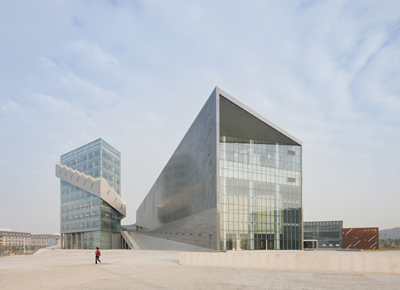
PSC [He shows the above image, and pauses]: And this is a very inexpensive building: 3000 RMB/square meter. In comparison, the museum [in Taiyuan] is twice the size so you’d expect the cost per square meter to be lower, but it’s much more expensive at 7800 RMB/sq. meter. So you've got to give me some leeway on this one.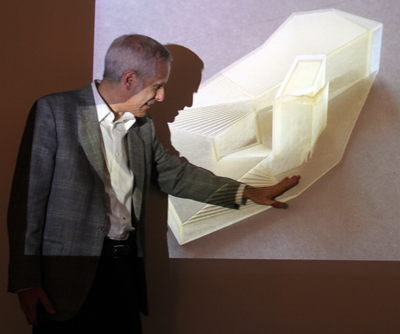
PSC: The building makes itself a landscape, if you will.*
PSC: And unlike Gehry’s Walt Disney Concert Hall, where the theater is completely symmetrical even though the rest of the building is not, here the exterior geometry is registered on the inside of the theater, without going so far as to disrupt the acoustics. 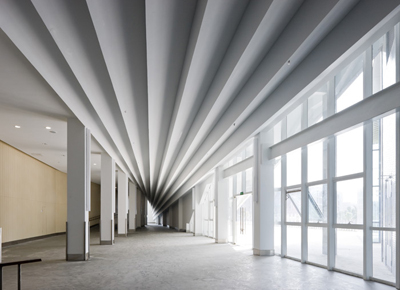
PSC: And this folded ceiling of the lobby is a kind of index of the façade. It's a dropped ceiling so it's an offset form [that is, it expresses the exterior without literally being produced by it]. 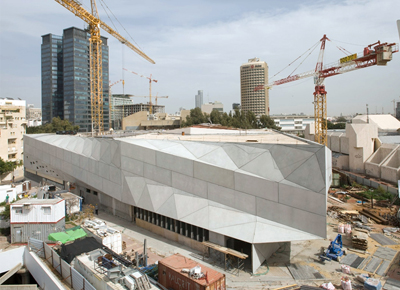
PSC [after some preamble about the museum in Tel-Aviv]: The envelope is really important here. You ALL know about panelization, and how important THAT is. [laughter all around. PSC is referring to the fact that we’ve worked through the panelization of complex surfaces in excruciating detail with him and Cameron Wu last year in our geometry class, and again, in a different way, with Andrew Witt from Gehry Technologies in this year’s Digital Project class.]
[…]
Mariana Ibanez [one of our studio’s critics, as we were looking at the plans]: Scott, how many seats in that auditorium?
PSC: Three seventy five. It's a very small, very small auditorium. But it's…very intense.
[One of my classmates]: Why is the façade panelized that way, with triangles?
PSC: Partly it’s theoretical, partly aesthetic and constructional. There’s the interest and beauty in building a curve with flat panels and making those lines evident, registering this information about the geometry. And it inscribes a certain scale, a scaleless scale to be honest; these panels are huge. And they're so smooth, they look like marble, so smooth that people are compelled to touch them.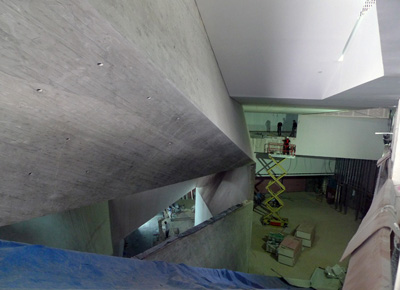
PSC: Actually the interior surfaces (as in the above photo) are the least geometrically rigorous, because the pieces of wood that the concrete was cast on are not infintesimally tapered, but straight, just twisted one to the next. Whereas the panelized exterior facade is the most rigorous. So it’s ironic that the increasing appearance of refinement actually corresponds with the less rigorous geometry in the construction.
[Now for Jonathan Levi’s question. I’d bet my firstborn that he did NOT enjoy Scott’s comment about the outsized scale of his façade panels creating a sense of scalelessness, since he’s been pushing us to articulate the relationship between our large masses and the scale and experience of a person on the street through tectonics at a human scale, in the panelization and composition of our elevations.]
JL: I have a two-part question. Part One: based on your thoughts at the beginning for the relationship between the interior and exterior, and now on the evidence of your work, how do you articulate the relationship between the interior and exterior? And Part Two is a riff off of what you showed us today, because you showed us a performing arts center and two museums. This raises the question: what is the distinct nature in civicness in these two types?
PSC: Whether we like it or not, the museum is so much about itinerary--the sequence of movement through the building--so the question becomes whether that is represented in a significant way on the outside of the building. That is the question of architecture here: if that is what so deeply characterizes it, should that be represented on the outside? Possibly. I think that's one way a museum would distinguish itself. The auditorium on the other hand, has a sense of entry which is much more theatricalized and centralized. It's not about itinerary so much as getting into the hall, which is the culminating main point. A museum doesn't have a main point like that; it's strung out with a series of points. And [in a performing arts center] there's something about the outside that would tell us that that on the inside there's some mighty space where everyone is sitting and witnessing something. Should the exterior have a formal genesis independent from the interior or not? You could approach this in two ways […]
JL: But to be frank, it's untenable to think of those two tendencies as morally equivalent. Because one of the tasks of architecture is to dedicate itself to describing its content in a way that is receivable, not just discoverable.
PSC: But take a classical dome. The inside has to do with an individual experience of infinity, of expansion through the aether to the heavens; it doesn't want to be expressed on the exterior in that way. The thickness of those shells means the outside of the building often has a totally different profile.
JL: But the expression, or not, of the dome on the outside is a separate project that architects have to dedicate themselves to, it's not something we can just leave to chance. [i.e. he’s not arguing for the exterior to be a direct transcription of the interior, but just for it to be crafted in some way.]
PSC: Yes of course. We agree there.
***
It was good times, and for those of us in the regular M.Arch.I program, a blast from the past. For the M.Arch.I APs, it was a glimpse in to our lives last year under the command of Captain Scott on the Flagship of the USS Graduate School of Design.
Thanks for reading!
Lian
P.S. For Preston Scott Cohen, see: http://www.pscohen.com/ and
http://www.nytimes.com/2010/09/12/arts/design/12nicolai.html?_r=1&ref=design
*This one made me laugh, because I’ve been telling my fellow blogger from GSD Landscape Architecture that in the Department of Architecture, when we talk about a building “acting as a landscape,” we mean nothing more and nothing less than a building being made of folded planes whose surfaces either suggest or allow for inhabitation (à la FOA’s Yokohama International Port Terminal). From this point of view, one would (almost) be forgiven for thinking that this other department at our school is actually called the Department of Folded Planes, which May or May Not have Grass on Them.
This blog was most active from 2009-2013. Writing about my experiences and life at Harvard GSD started out as a way for me to process my experiences as an M.Arch.I student, and evolved into a record of the intellectual and cultural life of the Cambridge architecture (and to a lesser extent, design/technology) community, through live-blogs. These days, I work as a data storyteller (and blogger at Littldata.com) in San Francisco, and still post here once in a while.



18 Comments
very nice work and glad they let you quote them.
I really like the architecture but find the rhetoric un-interesting, even pointless/boring. it comes off as architecture for architecture sake, which i'd like to not believe any progressive architect today would think is valid unless its a course on tectonics...
the performance piece was much more interesting/provocative. i am sooo glad you did that instead of more of denari. i mean we already HEARD everything denari has to say. interesting as he is it all seems so unimportant nowadays...my impression was that GSD was the place where new ideas would emerge, not the place where the once-new was being refined.
is that the wrong impression to take from the lecture and the kind of accidentally humorous mini-rant on the primacy of architecture at the beginning? you know, if one of the guys in charge is telling you the supposed Raison d'être of the school is just for show, whats the point of even setting up the school to be multi-disciplinary in the first place?
wow.... i can't believe scott said those things... i mean, not too surprised i guess, but sounds kinda messed up.. you'd think scott would be a little humbled by slipping to #2 in the rankings or would at least recognize that the school of architecture is doing absolutely nothing new or interesting while the other schools seem to at least be trying to be at the forefront of their profession instead of continuously rehashing the same old stuff out of one side of their mouths while criticizing any sort of contemporary design out of the other...
Oh Peedy, did someone forget to take his blue pill this morning?
Lian,
If you share so much of our special educational experiences with the outside they become less valuable, and, even though they said you could quote them, I don't like the idea of you as a press representative in all of meetings. It seems like this might detract from the frankness of discussion.
Yes,
It's great for archinect and the people looking to go to schools, but you need to draw the line somewhere. Ultimately you may be sacrificing the quality of your peers instruction for your own personal gain.
I don't see such avid reports coming out of Yale or Princeton, and after this post, I envy them.
@10: My feeling in this case was that PSC is well aware that he's a public person in the school, that he speaks to his public (students and faculty) in ways that he's very much in control of, and that he's not only aware of, but welcomes, the fact that sometimes this public gets expanded through avenues like my blog. (And often by avenues with much wider reach than my blog.)
This being said, yes, I am aware of the need to balance a candid reporting of public life and my experiences in the school with respect for cases where there's a reasonable expectation of privacy. I may make missteps in this at times, an I'd be happy to discuss this with you. But if you want to have such a discussion, you should tell me who you are, even if in private, so we can talk to each other like human beings.
wtf? asked if the comments were quotable and the answer was yes. that makes them explicitly intended for public consumption...no?
if the school isn't up to being scrutinised then how could it be worth going to?
so far the reporting/commentary is good and interesting. surely gsd would prefer to be represented by excellent students like this, no?
A good & stimulating read. No need for envious sniping amongst students... tsk tsk.
But I thought the GSD would have some kind of publicity/communications department for broadcasting stuff they deem important, instead of hectoring students with blogs to do that. Or has there been some serious cutbacks that haven't been revealed?
@ Helsinki: Thanks! Yes, the GSD has a substantial communications machine (somehow tied into the departments of exhibitions, publications, executive education, events, the library, the Dean's office, etc). What I do in this blog is independent--I haven't been selected or officially sanctioned by the school and I'm not governed by it.
Cutbacks? Not that I know of. The GSD relies less on endowments than other Harvard schools, so I suspect that the financial crisis of two years ago didn't have as substantial an affect here as at, say, the Law, Kennedy, Medical, and Divinity schools.
@ jump: I'm not ignoring your first comment (and thanks for that), but am brewing a response in the form of a future post on disciplinarity and the autonomy of architectural discourse. My short answer here would be that of course Scott is being deliberately provocative (and playing the role of the chair of the department, not the dean of the whole school) on the one hand, but on the other hand, I think he believes this. And while I'm not quite as fond of geometry as he is (who is?), I also tend to believe there's something valuable in going deep into a focused area of study to come up with something that can then speak in a wider sense. So my reading of this view would be that disciplinarity here is more about having a solid center of practices and discourses to start from and to base yourself out of, not about walling ourselves off from dealing with other concerns or ideas.
I enjoyed this entry, Lian. Thank you for writing it.
Architecture is certainly in an interesting time right now, being stretched (perhaps too thinly) into all kinds of realms where it probably belongs but where it should be mindful of being too hubristic.
Thanks for the link, Donna. What a strange article! I think Duany is spinning tales, conflating some stories and exaggerating others with deliberately misleading language and imagery.
I'll let my colleagues in Landscape and Urban Planning and Design deal with the facts on that side. But maybe I can just give one comment about the Ecological Urbanism conference, since I was there: For Rem to disavow his starchitect status and Drew Faust to insist on the importance of being green is platitudinous, not scandalous.
(Oh, and thanks for the rest of your comments, too. I'm curious what realms you see architecture stretching itself into these days? If anything, I have sometimes thought that architecture's mandate has gotten very small--or thin--making us the decorators of exterior form and designers of envelopes.
Hubris, of course, is always a risk. But I wonder if self-righteousness and earnestness without a sense of humor are even bigger risks. What I like about Scott is that he's entirely aware of his outsized personality and he has fun with it. He makes his provocations with a smile, because he enjoys the game of playing Scott.)
Just kidding about P.S.Cohen berating you for not "staying on message" and writing solely about the Arch.Department happenings - therefore trying to harness you for the use of the department.
---
Becoming "designers of envelopes" is a result of a relationship to practice - if you have a set of skills that are geared towards refining the way a surface is articulated, or the way a construction registers its own geometry, then those are your tools and that is the way architectural projects will be approached by you. And then, these are the skills developers and communities come to except from you.
Of course we gravitate easily towards things we can control - geometric studies, other kinds of paper architecture,... - instead of engaging with the mess of practice, where we have to accept other criteria and considerations. If an architect feels that he is marginalized to doing window dressing, the marginalizing force is not the result of a recalibration of architecture's mandate, imposed from above - but a result of a set of skills that really are good only for decorating.
---
Yes, I agree - a sense of humor is something that really gives discussions & critiques more potential - a certain amount of irreverence and playfullness keeps dogmatism at bay and can open up surprising possibilities (and yeah, P.S.Cohen must have a sense of humor - the guy looks like Steve Martin for god's sake.)
Haha! I see what you mean. About your first point, I think this had less to do with not getting enough, and more to do with the fact that you could always have more... like everything else around here I guess.
And yes, I agree that this has to do with where we decide we can have control. I hope that somewhere between this impulse and the impulse to design and manage whole landscapes and cities (landscape...urbanism?), most of us will be able to find a means and scale at which we can make a difference.
:)
I mean, he makes it his business to shape our minds in first year, so whatever you give him, he'll push for more. That's not a hidden agenda, that's an up-front unapologetically Scott-driven agenda.
But I'm not in first year anymore, so this was kind of just about making friendly conversation.
that is a good answer to a difficult probelm, lian.
like i said i quite like the architecture, i just don't see much point in talking about it. Getting it done is impressive enough in my book.
If I were honest with myself I am quite certain that is an aversion grown out of the failure of the philosophical dreams of the 1990's. Peter Eisenman and the then de rigueur Deleuze, Guattari, Liebnitz, A Thousand Plateaus, etc. Feels like it is all replaying, but with more formal mathematics. Without any social/higher ambition to anchor the work i can imagine it easily heading down another interesting dead end...just like the last time we trod this path.
which is fine, but why not aim higher?
unrelated, but is nice to hear that preston scott is smiling all the time while pushing his agenda.
What I really mean by "stretching", lian, is getting more involved in the larger context of the site: city, neighborhood, history, infrastructure, political forces - both physical context and social. My concern is that we pretend or imagine ourselves to be great at designing everything and not letting specialists (LAs, for example) do their thing in collaboration with us.
Hi Donna, thanks for the elaboration. I'm still not totally sure that I understand what you mean, though. Do you really think it's a stretch for architecture to engage with all of this? It seems to me that architecture always has to grapple with these. Yes, that may be hubristic but I'd suggest that's the nature of the discipline, to an extent (and that's definitely a double-edged sword).
On the subject of hubris...a dear colleague of mine (who shall remain unnamed because I can't remember how much alcohol had been consumed by the time this subject came up) suggested on Friday that design inherently has fascist tendencies. (This was in response to a comment I made that some of the national cultures with the most famously developed aesthetic sensibilities--Japan, Italy, and France were under discussion--can also be, to say the least, xenophobic.) He further speculated that it's a good thing that design usually fails (or is never completely successful in imposing itself), because we'd be living in a beautiful but miserable and inhuman world.
But maybe I've misunderstood your point. :)
And yes, I'm all for letting LAs plant their--
--actually, never mind. I should avoid the low-hanging fruit once in a while.
L
Hi this is great project.
Congrats
Block this user
Are you sure you want to block this user and hide all related comments throughout the site?
Archinect
This is your first comment on Archinect. Your comment will be visible once approved.